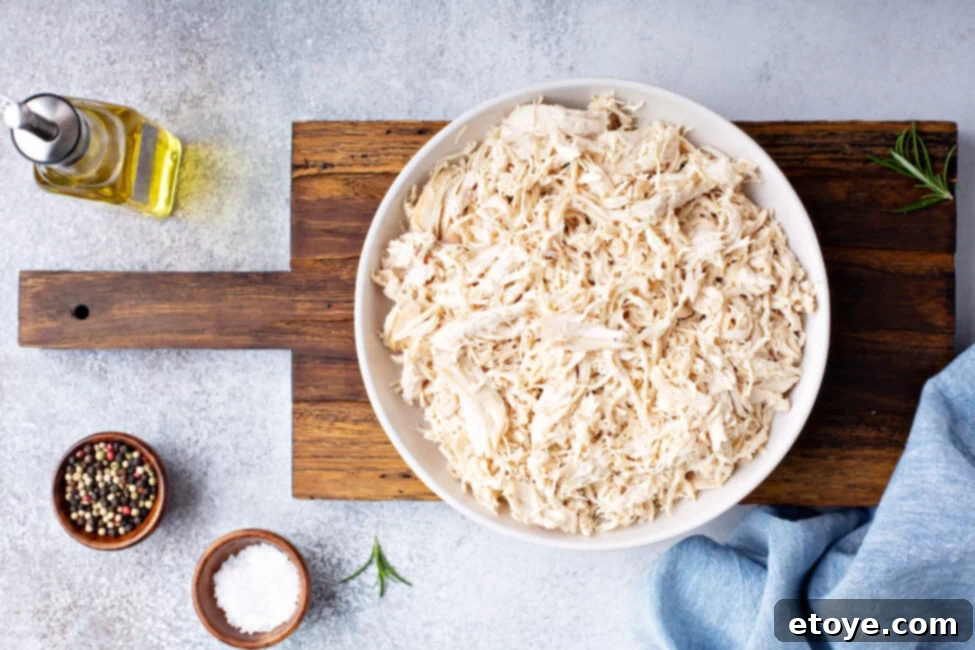You’ve successfully cooked a batch of chicken, perhaps for meal prep or a week’s worth of lunches, and now you’re faced with a common culinary dilemma: “How long can this delicious shredded chicken safely stay in my fridge before it’s no longer good?” Or maybe you’re eyeing yesterday’s dinner leftovers, wondering if they’re still fresh enough for tomorrow’s quick chicken salad. These are questions every home cook encounters, navigating the fine line between convenience and food safety.
In our busy lives, keeping track of the precise shelf life of various foods can feel like another chore. But when it comes to chicken, understanding proper storage and spoilage signs is crucial for your health and to minimize food waste. This comprehensive guide will equip you with all the knowledge you need to confidently store, identify, and enjoy your shredded chicken.
How Long Does Shredded Chicken Stay Good in the Fridge? The Definitive Answer
The golden rule for storing cooked and shredded chicken in the refrigerator is simple: **3 to 4 days**. This timeframe applies to chicken that has been cooked thoroughly and then properly stored. The keyword here is “properly stored,” as this makes all the difference in maintaining freshness and preventing the growth of harmful bacteria.
To ensure your shredded chicken remains safe and delicious for its maximum fridge life, immediate and correct storage is paramount. This means transferring the chicken into an airtight container or a heavy-duty, sealable freezer bag as soon as it has cooled down sufficiently, typically within two hours of cooking. Proper sealing prevents exposure to air, which can lead to bacterial contamination, flavor degradation, and drying out. Whether you’ve prepared a large batch for future meals like chicken enchiladas, quick tacos, or a healthy chicken salad, mastering these storage techniques will safeguard your culinary efforts and prevent unnecessary waste.

Key Factors Influencing the Freshness of Your Shredded Chicken
Several variables play a significant role in how long your shredded chicken will remain safe and palatable. Understanding these factors empowers you to take proactive steps to extend its shelf life.
- Temperature Control: Chicken, like most perishable foods, thrives in a cool environment, specifically below 40°F (4°C). The “danger zone” for bacterial growth lies between 40°F (4°C) and 140°F (60°C). In this temperature range, bacteria can multiply rapidly, sometimes doubling in number every 20 minutes, leading to spoilage and potential foodborne illness. Always ensure your refrigerator is set to 40°F or lower, ideally between 35°F and 38°F (1.7°C-3.3°C), to keep your chicken out of this hazardous zone. Furthermore, allow hot chicken to cool slightly before refrigerating, but don’t leave it at room temperature for more than two hours.
- Optimal Packaging: The way you package your shredded chicken directly impacts its longevity. Exposure to air, moisture, and potential cross-contamination from other foods can accelerate spoilage. An airtight container or a heavy-duty, sealable bag creates a barrier, protecting the chicken from these elements. By minimizing air exposure, you reduce the oxygen available for spoilage bacteria and prevent the chicken from drying out, thereby locking in its moisture and flavor. Vacuum sealing offers an even superior level of protection by removing almost all air.
- Initial Freshness of the Chicken: The quality of the chicken before it was cooked and shredded is a crucial, often overlooked, factor. If the raw chicken was already nearing its expiration date or had been stored improperly, cooking it won’t magically reset its freshness clock entirely. While cooking kills existing bacteria, the byproducts of bacterial growth can remain, and the overall integrity of the chicken might be compromised. Always start with the freshest possible raw chicken to ensure the longest possible safe storage life for your cooked leftovers.
- Added Ingredients and Marinades: What you add to your shredded chicken can either extend or shorten its shelf life. Some sauces, spices, or marinades contain natural preservatives like vinegar, lemon juice, or salt, which can slightly inhibit bacterial growth. Conversely, ingredients high in sugar, such as certain BBQ sauces or glazes, can paradoxically encourage faster spoilage by providing a food source for bacteria. Always consider the components of your dish when estimating the storage time.
Recognizing the Signs That Your Shredded Chicken Has Gone Bad
Your senses are your most reliable tools when it comes to detecting spoiled food. Trust your eyes, nose, and touch to determine if your shredded chicken is still safe to eat.
- Visual Cues (Sight): Begin by examining the chicken’s appearance. Freshly cooked shredded chicken typically has a natural white or light brown color. Signs of spoilage include a dull gray or greenish tint, which indicates bacterial growth. Any visible mold, appearing as fuzzy green, black, or white spots, is a definitive sign to discard the chicken immediately. Also, look for any unusual slime or stickiness on the surface.
- Textural Changes (Touch): If the chicken looks fine, gently touch a piece. Fresh shredded chicken should feel moist but firm. If it feels slimy, sticky, or unusually soft and mushy, it’s a clear indicator that bacteria have taken hold and it’s no longer safe to consume. This slimy residue is often a byproduct of bacterial metabolism.
- Olfactory Warnings (Smell): The smell test is often the most revealing. Fresh chicken should have a neutral, mild aroma. If your shredded chicken emits any sour, putrid, sulfurous (like rotten eggs), or ammonia-like odor, it has undoubtedly spoiled. Even a slightly “off” smell, different from what you expect, should be a red flag.
Remember this golden rule of food safety: **When in doubt, throw it out.** It’s never worth risking food poisoning, which can lead to severe gastrointestinal distress and other health complications. Your health is far more valuable than a few dollars’ worth of chicken.
Pro Tips for Maximizing the Shelf Life of Your Shredded Chicken
To keep your shredded chicken tasting as fresh as the day it was cooked, adopt these best practices for food storage and handling:
- Airtight Storage is Paramount: The single most effective way to extend shelf life is to minimize air exposure. Store your shredded chicken in high-quality airtight containers made of glass or BPA-free plastic. Alternatively, use sturdy, heavy-duty freezer bags, ensuring you press out as much air as possible before sealing. Less air means fewer opportunities for oxygen to cause oxidation and for airborne bacteria to proliferate.
- Rapid Cooling is Crucial: Don’t leave cooked chicken out at room temperature for extended periods. The goal is to get it out of the “danger zone” (40°F to 140°F) as quickly as possible. Break large quantities of chicken into smaller portions to cool faster. For very hot chicken, you can even use an ice bath (placing the container of chicken in a larger bowl filled with ice water) to accelerate cooling before refrigerating. Always refrigerate within two hours of cooking.
- Maintain Optimal Fridge Temperature: Regularly check your refrigerator’s temperature with a thermometer to ensure it consistently stays at or below 40°F (4°C). Fluctuating temperatures can compromise food safety. Avoid overcrowding your fridge, as this can impede air circulation and create warmer pockets.
- Leverage Food Preservation Gadgets: If you’re serious about food preservation, a vacuum sealer is an invaluable tool. It extracts almost all the air from storage bags or containers, creating an anaerobic environment that significantly slows bacterial growth and prevents freezer burn. Consider exploring options like the Avid Armor chamber vacuum sealer for superior results.
- Label and Date: Always label your containers with the date the chicken was cooked and stored. This simple habit helps you keep track of its freshness and ensures you consume it within the recommended 3-4 day window.
- Prevent Cross-Contamination: Always use clean utensils, cutting boards, and containers when handling cooked chicken. Store cooked chicken on upper shelves of the refrigerator, above raw meats, to prevent any drippings from contaminating it. Wash your hands thoroughly before and after handling food.

Creative Ways to Repurpose Leftover Shredded Chicken Before It Spoils
Don’t let that precious shredded chicken go to waste! With a little creativity, it can be transformed into a myriad of delicious and easy meals. Here are some inspiring ideas to use up your leftover chicken before its fridge life expires:
- Delectable Chicken Fried Rice: Give your shredded chicken a new life by tossing it into a vibrant chicken fried rice. Combine it with day-old rice, an assortment of colorful vegetables (peas, carrots, corn, bell peppers), a scrambled egg, and a savory soy sauce mixture for a quick, satisfying, and flavorful meal that’s perfect for lunch or a light dinner. Explore our Chicken Fried Rice recipe here.
- Heartwarming Chicken Noodle Soup: Nothing says comfort quite like a classic chicken noodle soup. Add your tender shredded chicken to a simmering broth with egg noodles, diced carrots, celery, and onions for a nourishing meal that’s perfect on a chilly day or when you’re feeling under the weather. It’s a fantastic way to stretch your chicken into a wholesome family favorite. Find our classic Chicken Noodle Soup recipe.
- Exotic Chicken Tandoori Buddha Bowl: Elevate your meal prep with a globally inspired dish. Incorporate your shredded chicken into a vibrant Buddha bowl alongside quinoa or rice, roasted vegetables, fresh greens, and a zesty minty Indian yogurt dressing for a healthy, flavorful, and incredibly satisfying meal. This recipe truly transforms leftovers into a gourmet experience. Try our Chicken Tandoori Buddha Bowl with Minty Indian Yogurt Dressing.
- Versatile Chicken Salad: A classic for a reason! Mix your shredded chicken with mayonnaise or Greek yogurt, celery, red onion, grapes, and a squeeze of lemon juice for a refreshing chicken salad. Serve it on whole-wheat bread, in lettuce cups, or as a topping for a green salad.
- Quick Chicken Tacos or Burritos: Warm the shredded chicken with your favorite taco seasoning, then serve it in tortillas with toppings like salsa, guacamole, cheese, and sour cream for an easy weeknight meal. It’s customizable and always a crowd-pleaser.
- Cheesy Chicken Quesadillas: Layer shredded chicken with cheese between two tortillas and cook until golden and crispy. Serve with salsa and sour cream for a fast and delicious snack or light meal.
- Savory Chicken Casseroles: Combine shredded chicken with pasta, rice, vegetables, and a creamy sauce, then bake until bubbly and hot. This is an excellent way to feed a family and use up various leftovers.
- BBQ Chicken Sandwiches: Toss shredded chicken with your favorite BBQ sauce and serve it on toasted buns with a side of coleslaw for a smoky and satisfying sandwich.
- Chicken and Vegetable Stir-Fry: Add your cooked chicken to a wok or pan with an array of colorful vegetables and a savory stir-fry sauce for a quick, healthy, and customizable meal.
- Stuffed Bell Peppers: Mix shredded chicken with rice, diced vegetables, and cheese, then stuff into bell pepper halves and bake until tender and bubbly.
The culinary possibilities with shredded chicken are virtually endless. Get creative and enjoy transforming your leftovers into exciting new dishes!
Frequently Asked Questions (FAQs) About Shredded Chicken Storage
Q: Can I freeze shredded chicken for longer storage?
A: Absolutely! Freezing is an excellent way to extend the life of your shredded chicken. Properly frozen shredded chicken can maintain its quality for 3 to 4 months. To prevent freezer burn and preserve freshness, ensure it’s stored in an airtight freezer bag or container, with as much air removed as possible. Thaw it safely in the refrigerator overnight before use.
Q: What are some favorite ways to use leftover shredded chicken?
A: Leftover shredded chicken is incredibly versatile. Popular uses include chicken tacos, burritos, quesadillas, chicken salad sandwiches or wraps, hearty chicken noodle soup, chicken pot pie filling, pizza topping, and adding it to stir-fries or casseroles. It’s a fantastic base for quick and healthy meals.
Q: Are there different methods to shred chicken?
A: Yes, there are several easy methods. For a small amount of chicken, two forks are effective. For larger quantities, a hand mixer on low speed or even a stand mixer with the paddle attachment can shred chicken in seconds, making meal prep much faster and easier.
Q: Can I use cooked chicken as lunch meat?
A: Definitely! Thinly slicing cooked chicken breast or thigh meat makes a healthy and delicious alternative to store-bought deli meats. It’s a great way to control ingredients and add lean protein to your sandwiches, salads, or wraps.
Q: Does the type of container matter when refrigerating shredded chicken?
A: Yes, it significantly matters. Always store shredded chicken in an airtight container or a tightly sealed, heavy-duty zip-top bag. This prevents the chicken from drying out, absorbs unwanted fridge odors, and protects it from airborne bacteria, thus maintaining its moisture and flavor for future use.
Q: Can I reheat shredded chicken multiple times?
A: While technically possible, it’s generally advised against. Reheating food multiple times increases the risk of it passing through the “danger zone” for bacterial growth. It’s best to reheat only the portion you intend to eat and then discard any further leftovers of that specific reheated portion.
Q: What’s the best way to reheat shredded chicken?
A: The best way to reheat shredded chicken depends on its intended use. For small amounts, a microwave works quickly. For larger batches or to prevent drying out, reheat it in a skillet with a splash of broth or water, or in the oven covered with foil, until it reaches an internal temperature of 165°F (74°C).
Q: How long can cooked chicken sit out at room temperature?
A: Cooked chicken should not sit out at room temperature for more than two hours. If the ambient temperature is above 90°F (32°C), this time limit shrinks to one hour. This is due to the rapid bacterial growth that occurs within the “danger zone.”
Get Shreddin’ and Stay Safe!
Congratulations! You’re now well-versed in the art of storing and maximizing the life of shredded chicken. By remembering a few key principles – keep it cool, keep it sealed, and always perform the “sniff test” – you can confidently enjoy your chicken creations without worry.
We’d love to hear from you! Do you have any foolproof chicken-saving tips, a go-to recipe that always impresses, or perhaps a humorous kitchen mishap involving chicken? Share your insights and stories in the comments below. Let’s continue to build our collective knowledge and passion for cooking!
Want More Kitchen Tips & Tricks?
- How to Defrost Chicken in the Microwave Safely
- How Long Does Lunch Meat Last in the Fridge?
- Should Eggs Be Refrigerated?
- How Long Does Ground Sausage Last In The Fridge?
